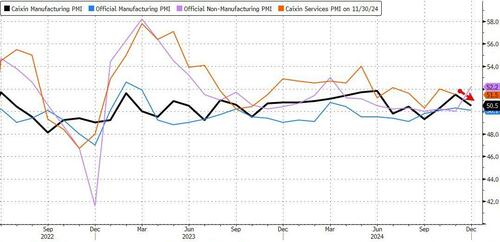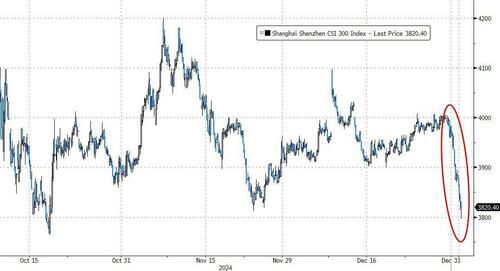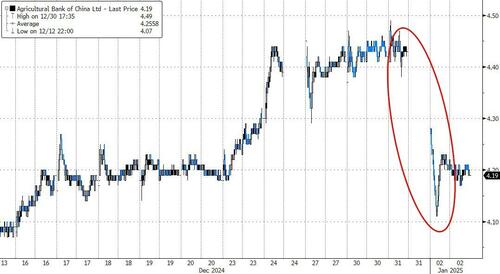“A Bit Troubling” – Chinese Stocks Suffer Worst Start To A Year Since 2016 As ‘Trump Effect’ Looms
China’s market turmoiled overnight after the Caixin Manufacturing PMI fell to 50.5 from 51.5 in November (significantly worse than the median forecast of 51.7 by economists).
The findings reflect uncertainties facing Chinese exports, which have powered the $18 trillion economy’s uneven recovery but may take a hit when Trump takes office later this month.
“Exports dragged on demand amid mounting uncertainties stemming from the overseas economic environment and global trade,” Wang Zhe, senior economist at Caixin Insight Group, said in a statement accompanying the release.
Chinese President Xi Jinping acknowledged new challenges from the external environment in a New Year’s Eve speech on Tuesday.
China’s 10-year government bond yields slid three basis points to 1.64%, a fresh record low. The offshore yuan gained 0.2% after the Chinese central bank set a strong fixing to support the currency.
But it was stocks that felt the brunt of the weakness, with Chinese stocks suffering the worst start to a year in nearly a decade.
“It’s a bit troubling that investors are starting the new year in a cautious mode as this is happening after clearer stimulus signals from Beijing during its December policy meetings,” said Homin Lee, senior macro strategist at Lombard Odier.
“The underlying momentum for China remains quite fragile, and it will take some efforts from the authorities to change the conversation on the country’s medium-term deflationary dangers.”
The CSI 300 Index closed down 2.9% on Thursday, its steepest drop on a year’s first day of trading since 2016. The Hang Seng China Enterprises Index slid as much as 3.1%.
The bloodbath in Beijing spread across most of Asia with MSCI AsiaPac down 0.6% with Taiwan and Hong Kong suffering most.
“As we position our funds into 1Q 2025, it just seems far more likely that downside risk is far greater than upside for China,” said Xin-Yao Ng, an investment director at abrdn Plc.
The biggest freefallers were the big Chinese banks led by major declines in AgBank, ICBC and CCB
“Financials in HK going ex-dividend contributed to the fall, but sentiment is fragile as we begin the new year,” says Kok Hoong Wong, head of institutional equities sales trading at Maybank Securities
Which leads us to ask, as Christopher Balding questions at The Epoch Times, just how dire is the situation of Chinese banks?
Lost amid all the different announcements of stimulus and busy work made to appear like stimulus is the regularity with which Chinese officials announce the funding of bank recapitalizations. Beijing rolled out small programs to boost consumption and help local governments start investing again, but the biggest funding items prop up bad banks.
All this funding for a sector supposedly with low levels of bad loans forces the question: how bad are Chinese banks?
Banks depend on capital and reserves to cover bad loans and remain liquid to cover daily cash demands from businesses and consumers. Because banks make money by investing that money in low-risk ways, such as lending cash to other banks or homes and businesses, banks do not hold all deposits in the form of cash. Banks hold cash and reserves to engage in their own business and serve the needs of their clients.
Chinese banks, by all official measures, claim to be doing very well. In the past year, most major Chinese banks reported higher levels of capital. Since the pandemic, China reports that official non-performing loan levels dropped from 1.73 percent in January 2022 to 1.56 percent in September of this year, down from 1.59 percent in September 2023. Officially, these numbers should be the picture of health for a banking system.
However, recent funding behavior by Beijing paints a more worrisome picture. In October, Beijing had a 1 trillion yuan bank recapitalization funding in 2024 by selling Chinese government bonds to provide the capital. Though details remain a little murky, China has announced sovereign debt funding amounting to 3 trillion yuan in 2025, with approximately 1–2 trillion yuan designated for additional bank recapitalization. Put another way, within the past three months, Beijing announced a potential bank recapitalization totaling as much as $415 billion, or 2–3 trillion yuan. This seems rather puzzling for a banking sector that is supposedly the picture of health.
The Chinese banking sector is under incredible strain despite the official cheery proclamations. Larger banks are rapidly swallowing small and mid-size banks. Though there is no official word on why these banks have been disappearing quickly, given their known precarious position, the primary suspicion is their risk to the larger system. City and county-wide banks have had to be rescued despite reporting safe and stable financial positions, leading to skepticism about rosy public proclamations.
Chinese banks have stated in their initial public offering documents that their accounting standards do not match those of banks in other countries, even though they use the same words and terms. One bank noted that it classifies a loan as doubtful if the business has not been operational for more than 12 months. Personally, that seems more than doubtful, but I am not a Chinese bank regulator.
As a simple example, in 2016, a Chinese steel company facing financial difficulty reported that a major subsidiary had not paid interest on loans since 2011. Evergrande, the failed mega developer, alone accounted for more than 50 percent of the Chinese economy’s officially counted bad loan reserves. Investors have good reason to be skeptical of official financial statements.
Though no official reason is given for why China has been spending large sums of money regularly on shoring up banks, the official whisper campaign is that in 2025, Beijing will unleash stimulus forces to get the economy going again. While anything is possible, it seems much more likely that Beijing is simply trying to fend off deep financial problems in the banks that keep funding everything they are told to fund.
Beijing has already announced it will start releasing restrictions on local government debt levels with heightened expectations for stimulus in 2025. At the recent Central Economic Work Conference, they shifted from prudent to ease, harkening back to language not seen since the global financial crisis in 2008. This may be true, but bank lending in November and December is below trend. While this may be storing up the ammunition for a 2025 rollout, it seems entirely possible the banks are just in bad shape, and the regular market expectations of Beijing stimulus will once again prove unfounded.
If China unleashes enormous fiscal stimulus in 2025, then there is some logic to the recapitalization splurge. Otherwise, this seems more about quietly staving off a financial crisis. Given the regularity with which Beijing has disappointed the hopes of investors calling for stimulus, it seems like the better bet is not to put your money in a Chinese bank.
Tyler Durden
Thu, 01/02/2025 – 08:29




